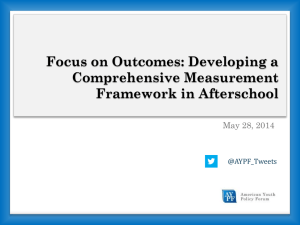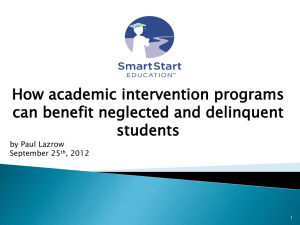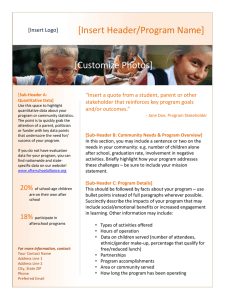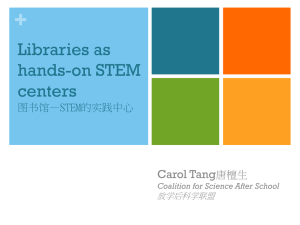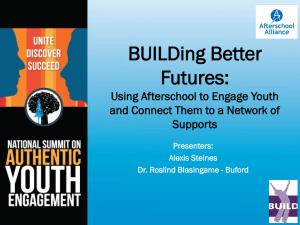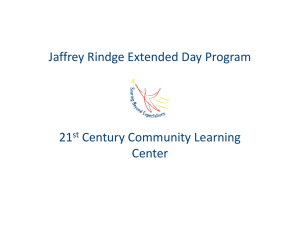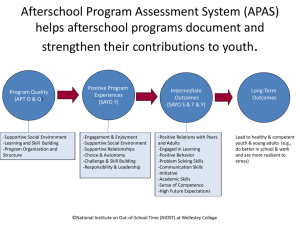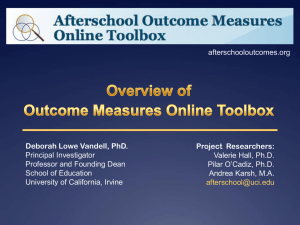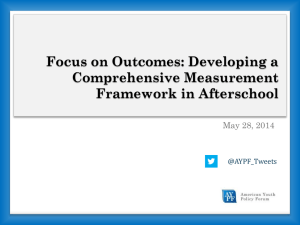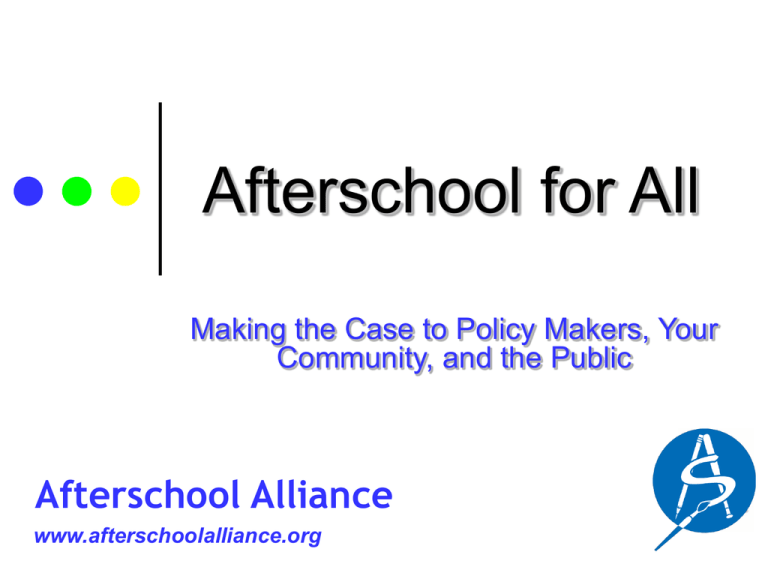
Afterschool for All
Making the Case to Policy Makers, Your
Community, and the Public
Afterschool Alliance
www.afterschoolalliance.org
What We’ll Cover
Making the Case:
Public Wants & Needs Afterschool
Afterschool Outcomes
Benefits to Bottom Line
Policy Matters: Funding & Resources for
Afterschool
National
State and Local
What You Can Do: Events, Media & More
www.afterschoolalliance.org
New America After 3pm Data
15.1 million of the country’s K-12 youth take care
of themselves after school
3 to 6 p.m. are the most dangerous hours for kids.
Juvenile crime soars
Peak hours for drugs, alcohol, cigarettes and sex
Lack of physical activity/obesity
Parents of 18 million children, or 38%, would sign
up for an afterschool program – if one were
available
www.afterschoolalliance.org
Demand for Afterschool
Programs
83% of voters agree – children need a place to
go afterschool that is organized, safe, and
educational
76% - newly elected officials in Congress
should increase funding for afterschool
69% of voters - support tax increase
94% Democrats, 83% Independents, 71%
Republicans – there’s a need for an organized,
safe place for children and teens afterschool
Source: Afterschool Alliance Poll conducted by Lake,
Snell, Perry & Associates, Inc., November 2006 and 2008
www.afterschoolalliance.org
Benefits of Quality
Afterschool Programs
Improved Test Scores and Grades
21st CCLC participants nationwide—43% improved reading
scores, 42% improved math scores
In California, higher academic achievement, test scores
In Ohio, higher scores in every subject tested
Oct 2007 study – big gains in test scores, work habits
Improved School Attendance, Engagement in
Learning
More likely to come to school, stay in school and graduate
In NY, higher daily attendance and credit accumulation
In Chicago, higher class attendance, lower course failure,
higher graduation rates
Los Angeles program reduced drop out rate by 20%
www.afterschoolalliance.org
Benefits of Quality
Afterschool Programs
Improved Social and Emotional Behavior
Lower truancy, drug use, violence
teen pregnancy
Greater self-confidence
Develop leadership, critical thinking,
team-building skills
Improved Health and Wellness
Structured physical activities, healthy
snacks help prevent weight gain tied to
inactivity after school and during summer
www.afterschoolalliance.org
Benefits to Bottom Line
Rose Institute
Catalyst Study (December 2006)
Every dollar invested in afterschool programs saves
taxpayers at least $3
New Catalyst Study - $50-$300 billion/year due to lost
productivity
PCAST – Parental Concern about Afterschool Time
Low-income and minority parents are much more likely
than higher-income, white parents to have trouble
finding high-quality, convenient and affordable
programs.
Corporate Voices for Working Families
“After School For All: A Call To Action From The
Business Community”
www.afterschoolalliance.org
Who’s Doing What
www.afterschoolalliance.org
Federal Afterschool Policy
Federal Funding Picture
FY
21st Century Community
2002
2003
Learning Centers $35 million
2004
increase for FY10
2005
ESEA (NCLB) authorized
2006
$2.5 billion
2007
2008
Other sources of afterschool
2009
money: CCDBG, OJJDP, SES,
2010
Department of Agriculture
2011
New Initiatives: Rural
Afterschool and Afterschool for
Older Youth
www.afterschoolalliance.org
Amount
Appropriated
$1 billion
Amount
Called for
in NCLB
$1.25 billion
$993.5M
$1.5 billion
$991M
$1.75 billion
$991M
$2 billion
$981M
$2.25 billion
$981M
$2.5 billion
$1.1 B
$2.5 billion
$1.13 B
$2.5 billion
$1.166 B
$2.5 billion
$1.153 B
$2.5 billion
Reauthorization of the Elementary
and Secondary Education Act
The President’s Budget and ESEA proposal would divert 21st Century
Community Learning Centers program funding away from afterschool
programming toward adding time to the school day, without a clear role
for community partners nor parameters on how the time is used.
21st CCLC funding already can be used to support afterschool
components of full service community schools, however proposed
changes would hinder the movement towards developing a new, large
source of federal community schools funding.
Proposal turns 21st CCLC program into a competitive grant program,
rather than one working by formula. Some states would be left out.
“We need a dedicated funding stream for 21st Century Community
Learning Centers, and we have a strong preference that the funding for
full-service community schools be a distinct funding stream. The
leverage for full-service service community schools will be more
significant if it is grown as a distinct funding stream.”
www.afterschoolalliance.org
State and Local funding
Statewide Afterschool Networks
Creative and Diverse Ways to Fund
Afterschool
CA – $550 million to K-8 programs – ASES
GA – $14 million to school- and communitybased afterschool programs through TANF,
renewed for FY09, plus $20.3 million in onetime funds
TN – $12.5 million unclaimed lottery funds
(LEAP)
Local community foundations
Mayoral/Citywide Initiatives
www.afterschoolalliance.org
www.afterschoolalliance.org
Roadmap to Afterschool for All
On average parents pay 76% of the cost of afterschool
through tuition and fees
54% in low income communities
Currently the federal government contributes only 11% of
the cost of afterschool
State contribute 3.1% of cost
The Roadmap calls for a total federal investment of just
under $18 billion ($17,935,775,000) – would reduce the
burden on low-income families while providing 5.6
million low-income youth with access to
afterschool programs
www.afterschoolalliance.org
What You Can Do
www.afterschoolalliance.org
Afterschool as a Platform
for…Everything!
Health Care
Workforce prep
Nutrition/Physical Health
Service learning/Community
Engagement
Academic Skills
Family Involvement in Schools
www.afterschoolalliance.org
October 21, 2010
www.afterschoolalliance.org
Lights On Afterschool!
Annual nationwide event
Brings attention to the need for afterschool
programs and resources
8,000+ events and 1 million Americans
nationwide
National Chair Governor Arnold
Schwarzenegger; Kevin Sorbo and Rhea
Perlman as spokespeople
Thousands of newspaper & TV stories
Build relationships w/ business community,
neighborhood leaders, elected officials
www.afterschoolalliance.org
Group Activity
Using a Lights On Afterschool event as
your framework, brainstorm community
outreach techniques and strategies for
effective messaging.
Presenter will pass out detailed
instructions.
www.afterschoolalliance.org
Arrange a Site Visit
Ask your Members of Congress, local policy makers and
media to visit your afterschool program: Help your elected
officials and your community establish a personal connection to
afterschool by inviting them to visit a program and see firsthand
how it is helping kids and families
Find the home district address and phone number for
your elected officials.
Identify a few dates during the next Congressional
recess when you could host a tour of your program.
Call the district office.
Before the visit: Identify youth, parents, program staff,
school officials and community partners who would be
convincing spokespeople for your program.
What to do the day of the visit.
www.afterschoolalliance.org
Ten Steps to Media Coverage
Create a Media List.
2.
Invite the Public.
3.
Identify your 2-3 key messages.
Structure events with media in mind.
Appeal to the press, build relationships.
6.
Issue news releases.
7.
Develop press kits.
8.
Manage media at your events.
9.
Event management.
10. Reap the benefits of your work!
1.
4.
5.
www.afterschoolalliance.org
Contact Congress
Call, write or email
Meet district staff
Afterschool for All Challenge
Joint
conference with NAA this year, April
19-21, Washington, DC
Honoring leaders in Congress and in the
States
Let Members of Congress hear from
you and your youth about afterschool
www.afterschoolalliance.org
Messages for Congress
These are tough economic times and now is not the time to cause additional
pain to working families.
15 million children are unsupervised after school every day – we need to
work together to increase opportunities afterschool – and to insure that the
exciting partnerships that bring extended learning opportunities to our
children continue to build in scope and quality.
The afterschool community embraces reform –merely adding more time is
not the answer –in communities that choose a longer school day it is
imperative to focus on content and delivery.
We believe that if community partners work with schools to shape a longer
school day/year and are true partners in the delivery (and receipt of funding)
then these programs have a higher likelihood of success.
Innovative school reform that embraces these partnerships should have its
own funding stream.
There is very little data on a longer school day so we should proceed with
caution and move slowly.
Other states, show promising models of extending the school day. In Rhode
Island and New York community partners have been working with the
school districts to develop and implement plans.
www.afterschoolalliance.org
Afterschool for All
Show
your support for afterschool
programs and what they do for our children,
families and communities
Register your support & be recognized by
Afterschool for All campaign
Thousands
of leaders, organizations and
businesses already on board
Sign up at
http://www.afterschool2010.org/a4aJoin.cfm
www.afterschoolalliance.org
Nominate a Program to win
MetLife Award and $5000
MetLife Foundation and Afterschool Alliance
Awards of $5000 and featured in issue brief
Middle School Programs in 4 areas
Overall high quality MS programs
STEM
Health & Wellness
Prep for College & Careers
www.afterschoolalliance.org/metLife.cfm
www.afterschoolalliance.org
Stay in touch!
Rivka Burstein-Stern
Field Outreach Coordinator
Afterschool Alliance
(202) 347-2030
rburstein@afterschoolalliance.org
www.afterschoolalliance.org
www.afterschoolalliance.org

